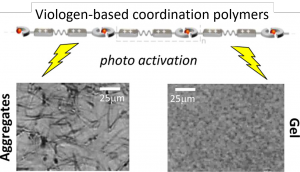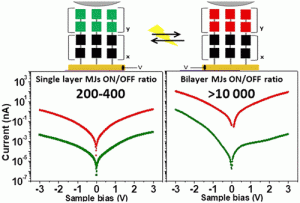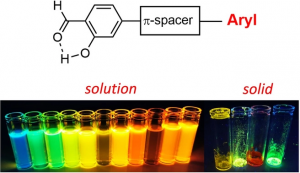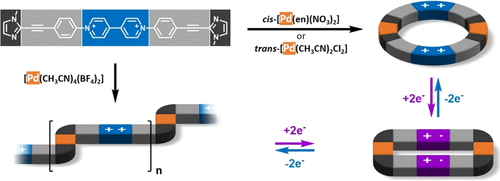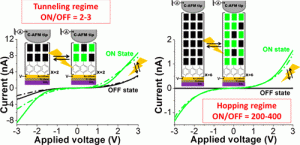Our article is available to read at ECS J. Solid State Sci. Technol.
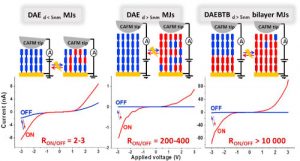 Through electrochemical deposition, photoswitchable single and bilayer molecular junctions based on diarylethene (DAE) and bisthienylbenzene (BTB) layers were fabricated. The electrical characterization of closed and open forms of DAE were investigated by C-AFM for two different layer thicknesses fixed at 2–3 nm and 8–9 nm, i.e. below and above the direct tunneling limit. Both layers switch between high and low conductance modes (« ON » and « OFF » states) when irradiated by UV and visible light. ON/OFF ratios of 2–3 and 200–400 were obtained for 3 nm- and 9 nm-thick DAE MJs, respectively. Next, we prepared 9 nm-thick MJs using a bi-layer system. The first layer (5 nm) is based on BTB oligomers. The second layer (4 nm) is based on DAE oligomers. The impact of this first layer on the switchable properties of the system, and on the photoresponse of the 9 nm-thick DAE-based MJs has been studied. The DAE/BTB bilayer generates new electronic functions combining photoswitching and photorectification. The open form of DAE/BTB shows low conductance and asymmetric I(V) curves while the closed form shows symmetric I(V) curves and high conductance. More importantly, unprecedented ON/OFF current ratios of over 10 000 at 1 volt were reproducibly measured.
Through electrochemical deposition, photoswitchable single and bilayer molecular junctions based on diarylethene (DAE) and bisthienylbenzene (BTB) layers were fabricated. The electrical characterization of closed and open forms of DAE were investigated by C-AFM for two different layer thicknesses fixed at 2–3 nm and 8–9 nm, i.e. below and above the direct tunneling limit. Both layers switch between high and low conductance modes (« ON » and « OFF » states) when irradiated by UV and visible light. ON/OFF ratios of 2–3 and 200–400 were obtained for 3 nm- and 9 nm-thick DAE MJs, respectively. Next, we prepared 9 nm-thick MJs using a bi-layer system. The first layer (5 nm) is based on BTB oligomers. The second layer (4 nm) is based on DAE oligomers. The impact of this first layer on the switchable properties of the system, and on the photoresponse of the 9 nm-thick DAE-based MJs has been studied. The DAE/BTB bilayer generates new electronic functions combining photoswitching and photorectification. The open form of DAE/BTB shows low conductance and asymmetric I(V) curves while the closed form shows symmetric I(V) curves and high conductance. More importantly, unprecedented ON/OFF current ratios of over 10 000 at 1 volt were reproducibly measured.


